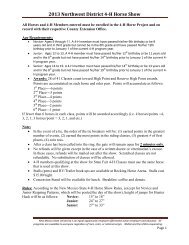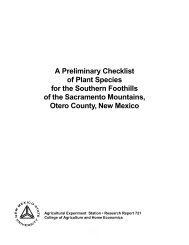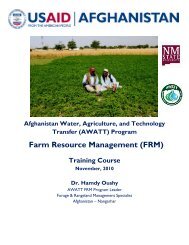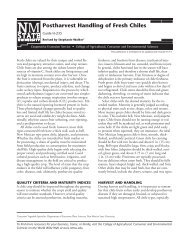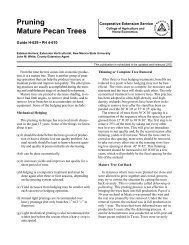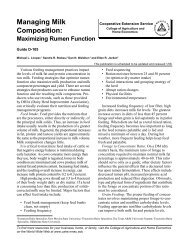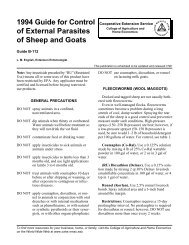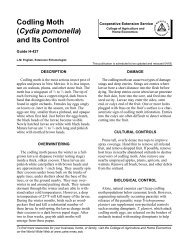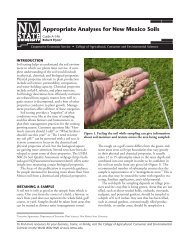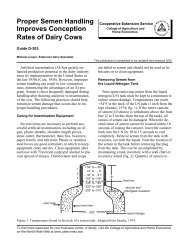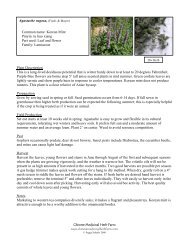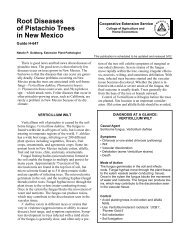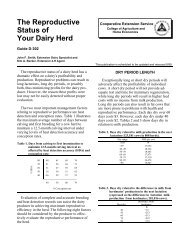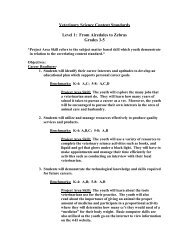Cuscuta spp. - College of Agricultural, Consumer and Environmental ...
Cuscuta spp. - College of Agricultural, Consumer and Environmental ...
Cuscuta spp. - College of Agricultural, Consumer and Environmental ...
You also want an ePaper? Increase the reach of your titles
YUMPU automatically turns print PDFs into web optimized ePapers that Google loves.
Dodder (<strong>Cuscuta</strong> <strong>spp</strong>.) Biology <strong>and</strong> Management<br />
Guide A-615<br />
Jamshid Ashigh <strong>and</strong> Esther E. Marquez 1<br />
Cooperative Extension Service • <strong>College</strong> <strong>of</strong> <strong>Agricultural</strong>, <strong>Consumer</strong> <strong>and</strong> <strong>Environmental</strong> Sciences<br />
This publication is scheduled to be updated <strong>and</strong> reissued 1/15.<br />
Introduction<br />
There are over 150 species <strong>of</strong> dodders (<strong>Cuscuta</strong> <strong>spp</strong>.)<br />
worldwide. Belonging to the Convolvulaceae plant<br />
family, dodders are annual parasitic plants that reproduce<br />
by seed <strong>and</strong> do not have any leaves or chlorophyll<br />
to live from—they therefore must obtain all <strong>of</strong><br />
their growth requirements (water, minerals, carbohydrates)<br />
by attaching themselves to other living green<br />
plants (host plants). Host plants include those grown<br />
for agricultural purpose, ornamental plants, range<br />
plants, <strong>and</strong> weeds.<br />
Description <strong>and</strong> Life Cycle<br />
In the spring, dodder seeds germinate near the soil<br />
surface <strong>and</strong> send up slender, thread-like twining stems<br />
varying in color from pale green to yellow or orange<br />
<strong>and</strong> without any cotyledons (seed leaves). The slender,<br />
leafless, thread-like stem sways or rotates slowly until it<br />
touches the stem or leaf <strong>of</strong> another plant <strong>and</strong> begins to<br />
wind around it (Figure 1). On a host plant, the dodder<br />
stem will immediately form small appendages called<br />
haustoria (tiny sucker-like roots), which penetrate the<br />
stems or leaves so that dodder can extract its necessary<br />
growth requirements. Soon after attaching to a host<br />
plant, the lower end <strong>of</strong> the dodder withers <strong>and</strong> breaks its<br />
connection with the ground, while the upper part <strong>of</strong> the<br />
stem grows rapidly, <strong>of</strong>ten forming dense stringy masses.<br />
However, if the dodder seedlings are unable to contact a<br />
susceptible host plant soon after germination, they will<br />
not survive.<br />
Dodder flowers are numerous, tiny, whitish to pinkish,<br />
<strong>and</strong> form in small clusters along the stems, generally<br />
from May to October, depending on the species <strong>and</strong><br />
location. Each flower forms a small, globular seedpod<br />
with 2 to 4 seeds (Figure 2). The seeds have rough coats<br />
<strong>and</strong> vary in size, depending on the species, <strong>and</strong> may be<br />
able to survive over 20 years in the soil.<br />
Figure 1. Dodder parasitizing a tomato plant. Picture<br />
from Weeds <strong>of</strong> California <strong>and</strong> Other Western States.<br />
(Photo by J.M. DiTomaso; used with permission.)<br />
Problems<br />
Although there are several species <strong>of</strong> dodder distributed<br />
throughout North America, the most common species<br />
in Western United States are largeseed dodder (C. indecora)<br />
<strong>and</strong> field dodder (C. campestris). These species<br />
have become a major economic concern in alfalfa, clover,<br />
tomatoes, <strong>and</strong> potatoes. Dodder infestations reduce<br />
crop yield <strong>and</strong> increase harvesting costs. The damage <strong>of</strong><br />
dodder to the host plant varies from moderate to severe<br />
depending on the growth <strong>of</strong> the host plant <strong>and</strong> on the<br />
number <strong>of</strong> haustoria attachments to the host plant.<br />
Management<br />
Dodder management is only achieved using combined<br />
preventive, cultural, mechanical <strong>and</strong> chemical methods<br />
that aim at control <strong>of</strong> existing populations prior to seed<br />
production <strong>and</strong> control <strong>of</strong> subsequent seedlings. Fields<br />
1<br />
Respectively, Extension Weed Specialist/Assistant Pr<strong>of</strong>essor <strong>and</strong> Research Assistant, Department <strong>of</strong> Extension Plant Sciences, New Mexico State University.<br />
To find more resources for your business, home, or family, visit the <strong>College</strong> <strong>of</strong> <strong>Agricultural</strong>, <strong>Consumer</strong> <strong>and</strong> <strong>Environmental</strong><br />
Sciences on the World Wide Web at aces.nmsu.edu
Figure 2. Dodder flowers in small clusters along the stems. Pictures from Weeds <strong>of</strong> California <strong>and</strong> Other Western States.<br />
(Photos by J.M. DiTomaso; used with permission.)<br />
with dodder history need to be monitored frequently, <strong>and</strong><br />
new dodder plants must be removed as soon as possible.<br />
Prevention<br />
Preventive management includes planting dodder-free<br />
crop seeds, cleaning agricultural machinery before moving<br />
from an infested area to a non-infested area, <strong>and</strong> managing<br />
existing populations prior to seed production so as to<br />
not spread dodder seeds. While small infestations can be<br />
removed by h<strong>and</strong> to prevent the production <strong>of</strong> the seed,<br />
the recommendation for controlling extensive infestations<br />
is to remove the host plant <strong>and</strong>, if possible, replant with<br />
non-host crops.<br />
Cultural Control<br />
Planting non-host grass crops (e.g., corn, sorghum),<br />
winter crops (e.g., winter wheat, broccoli, legumes),<br />
<strong>and</strong> transplanted trees with bark (e.g., pecan) can be<br />
effective in managing dodder in an infested area. However,<br />
certain broadleaf weeds such as pigweeds, lambsquarters,<br />
Russian thistle, <strong>and</strong> field bindweed serve as dodder host<br />
plants <strong>and</strong> will need to be controlled as part <strong>of</strong> a successful<br />
dodder management strategy. Furthermore, due to the longevity<br />
<strong>of</strong> dodder seed, once a host crop is planted again<br />
fields need to be monitored regularly, <strong>and</strong> new dodder<br />
plants must be removed immediately.<br />
Mechanical Control<br />
Dodder infestation can be decreased by h<strong>and</strong>-pulling,<br />
burning, cutting, or close mowing <strong>of</strong> the infested plants.<br />
If growers decide to use cultivation for dodder control,<br />
cultivation should be done prior to dodder’s attachment<br />
to the host plant.<br />
Chemical Control<br />
Several post-emergence (POST) <strong>and</strong> pre-emergence<br />
(PRE) herbicides are effective for dodder control/<br />
suppression. Common PRE herbicides (applied prior<br />
to dodder emergence) for dodder control include Kerb<br />
(pronamide), Treflan (trifluralin), <strong>and</strong> Prowl (pendimethalin).<br />
POST application (applied after dodder<br />
emergence) <strong>of</strong> Dacthal (DCPA), Scythe (pelargonic<br />
acid), Raptor (imazamox), Pursuit (imazethapyr), <strong>and</strong><br />
Gramoxone (paraquat) have been shown to be effective<br />
in dodder control/suppression (Table 1). Broadcast or<br />
selective (spot treatment) application <strong>of</strong> Roundup<br />
(glyphosate) also has been shown to provide good control<br />
<strong>of</strong> dodder; however, spot treatments <strong>of</strong> Roundup will<br />
result in crop injury in non-Roundup Ready crops.<br />
Acknowledgments<br />
The critical reviews <strong>of</strong> this article by Dr. Jill Schroeder,<br />
Ms. Cheryl Fiore, <strong>and</strong> Mr. Mike Cowbrough are acknowledged.<br />
Guide A-615 • Page 2
Table 1. Recommended POST <strong>and</strong> PRE Herbicides (Based on Dodder Emergence <strong>and</strong> Their Crop Registration) for Dodder Control in New Mexico a<br />
Herbicide Alfalfa Clover Tomato Potato<br />
(Active ingredient) (rate/acre) (rate/acre) (rate/acre) (rate/acre) Remarks<br />
Kerb PRE PRE NR b NR Required rates depend on type <strong>of</strong> irrigation. Excessive amounts <strong>of</strong> irrigation water following Kerb herbicide<br />
(pronamide) (3–4 lb) (3–4 lb) application may adversely affect the herbicide activity.<br />
Treflan PRE NR PRE PRE For optimum dodder control, the highest labeled rate should be used. Due to the lower registered rates in tomato <strong>and</strong><br />
(trifluralin) (1–4 pt) (1–2 pt) (1–2 pt) potato, herbicide could only provide partial control.<br />
Prowl H 2<br />
O PRE NR PRE PRE For optimum dodder control, the highest labeled rate should be used. In seedling alfalfa, application rate is 1–2 pt <strong>of</strong><br />
(pendimethalin) (1–4 qt) (1.5–3 pt) (1.5–3 pt) Prowl/acre.<br />
Roundup 4S POST NR NR NR Broadcast application is only recommended on Roundup Ready alfalfa. However, in conventional alfalfa, Roundup may<br />
(glyphosate) (4 pt) be applied as a spot treatment or with wiper applicators. Applications may be made in the same area at 30-day intervals;<br />
however, no more than 10 percent <strong>of</strong> the total field area should be treated at one time.<br />
Dacthal NR NR PRE NR Tomato plants should be well-established prior to Dacthal application. For optimum dodder control, the highest labeled<br />
(DCPA) (6–14 lb) rate should be used.<br />
Raptor POST POST NR NR Raptor suppresses dodder prior to its attachment to the host plant. For optimum dodder control, the highest labeled rate<br />
(imazamox) (4–6 fl oz) (5 fl oz) should be used.<br />
Pursuit POST POST NR NR Pursuit suppresses dodder prior to its attachment to the host plant. For best results, Pursuit should be applied with crop<br />
(imazethapyr) (3–6 fl oz) (3-6 fl oz) oil concentrate or methylated seed oil. For optimum dodder control, the highest labeled rate should be used.<br />
Gramoxone Extra POST POST NR NR Gramoxone is a restricted-use herbicide, so the applicator is required to be certified. Apply between cuttings but<br />
(paraquat) (12.8 fl oz) (13–24 fl oz) before regrowth for dodder suppression. Gramoxone will damage emerged or green plants. The rate <strong>of</strong> 12.8 fl oz <strong>of</strong><br />
Gramoxone/acre is registered for between-cutting applications.<br />
Scythe POST POST NR NR Apply between cuttings but before regrowth for dodder suppression. Scythe will damage emerged or green plants.<br />
(pelargonic acid) (Variable, 3–7%) (Variable, 3–7%)<br />
a Other trade names <strong>of</strong> the active ingredients alone or in combination may be available in the market. When considering the use <strong>of</strong> an herbicide, nothing can take the place <strong>of</strong> reading the label <strong>and</strong> making<br />
applications according to label directions. Most labels can be accessed at either http://greenbook.net or http://cdms.net.<br />
b NR = Not registered<br />
Guide A-615 • Page 3
References:<br />
Alex, J.F. 1998. Ontario Weeds (Publication 505).<br />
Guelph: Ontario Ministry <strong>of</strong> Agriculture, Food, <strong>and</strong><br />
Rural Affairs.<br />
Cudney, D.W., S.B. Orl<strong>of</strong>f, <strong>and</strong> J.S. Reints. 1992. An<br />
integrated weed management procedure for the<br />
control <strong>of</strong> dodder (<strong>Cuscuta</strong> indecora) in alfalfa<br />
(Medicago sativa). Weed Technology, 6, 603–606.<br />
Dawson, J.H., <strong>and</strong> A.R. Saghir. 1983. Herbicides applied<br />
to dodder (<strong>Cuscuta</strong> <strong>spp</strong>.) after attachment to alfalfa<br />
(Medicago sativa). Weed Science, 31, 465-471.<br />
DiTomaso, J.M., <strong>and</strong> E.A. Healey. 2007. Weeds <strong>of</strong> California<br />
<strong>and</strong> Other Western States (Publication 3488).<br />
Davis: University <strong>of</strong> California Agriculture <strong>and</strong><br />
Natural Resources.<br />
Lanini, W.T., D.W. Cudney, G. Miyao, <strong>and</strong><br />
K.J. Hembree. 2002. Dodder. Davis: University <strong>of</strong><br />
California Agriculture <strong>and</strong> Natural Resources. Accessed<br />
April 2, 2009 at http://www.ipm.ucdavis.<br />
edu/PDF/PESTNOTES/pndodder.pdf<br />
Whitson, T.D., L.C. Burrill, S.A. Dewey, D.W. Cudney,<br />
B.E. Nelson, R.D. Lee, <strong>and</strong> R. Parker. 2006. Weeds<br />
<strong>of</strong> the West (9th Edition). The Western Society <strong>of</strong><br />
Weed Science in cooperation with the Western<br />
United States L<strong>and</strong> Grant Universities Cooperative<br />
Extension Services.<br />
The recommendations in this publication are provided<br />
only as a guide. The authors <strong>and</strong> New Mexico<br />
State University assume no liability resulting from<br />
their use. Mention <strong>of</strong> specific products does not imply<br />
an endorsement or guarantee <strong>of</strong> those products, nor<br />
does it imply criticism <strong>of</strong> other, similar products.<br />
Please be aware that pesticide labels <strong>and</strong> registration<br />
can change at any time; by law, it is the<br />
applicator’s responsibility to use pesticides ONLY<br />
according to the directions on the current label. Use<br />
pesticides selectively <strong>and</strong> carefully <strong>and</strong> follow recommended<br />
procedures for the safe storage <strong>and</strong> disposal<br />
<strong>of</strong> surplus pesticides <strong>and</strong> containers.<br />
Contents <strong>of</strong> publications may be freely reproduced for educational purposes. All other rights reserved. For permission to use<br />
publications for other purposes, contact pubs@nmsu.edu or the authors listed on the publication.<br />
New Mexico State University is an equal opportunity/affirmative action employer <strong>and</strong> educator. NMSU <strong>and</strong> the U.S. Department<br />
<strong>of</strong> Agriculture cooperating.<br />
January 2010<br />
Las Cruces, NM<br />
Guide A-615 • Page 4



